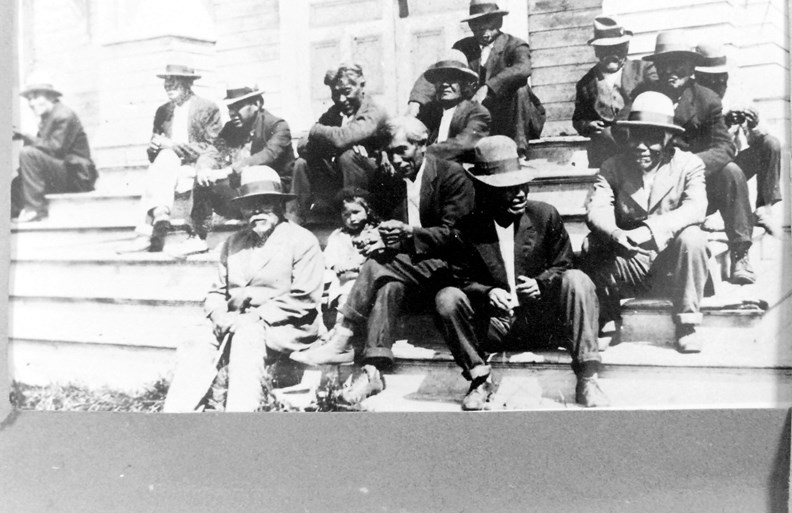History
The Sechelt (shíshálh) Nation was once a thriving people made up of four distinct groups from across its territory – xénichen from the head of Jervis Inlet, ts’únay from Deserted Bay, téwánkw from Sechelt, Salmon and Narrow inlets and sxixus from Lang Bay, Pender Harbour and the Roberts Creek area.
Together the four groups had a population of over 4,000 people in the early 1800s, before European contact.
Once visited by European settlers, the First Nation populations were exposed to new diseases like smallpox, which had a devastating effect on the Aboriginals, resulting in massive deaths.
By 1902 the total population of what is now known as the shíshálh Nation had dwindled to just over 160.
Ultimately the Catholic church system brought in by the Europeans and the passing of the Indian Act resulted in a gathering of all the shíshálh people to Sechelt, to be taught the ways of the settlers in an effort to assimilate them into European society.
Starting in 1912, First Nation children in Sechelt were forced into residential school where they were severely punished for speaking their language. Adults were also watched closely and punished for trying to practise traditional ways of life or speak their language in public.
shíshálh Nation elders have recounted terrible scenes of having needles pierced through their tongues if caught speaking their own language. Children were also beaten, starved and sexually preyed upon while in residential school.
Sechelt’s residential school ultimately closed in 1975, after decades of oppression that almost caused the Nation to lose its language and culture entirely, but the shíshálh Nation is a strong and determined people.
Elders, seeing the need in the 1970s, got together with linguist Ron Beaumont to start recording words in their traditional sháshishálem language. After a 40-year effort, Beaumont produced a dictionary with about 10,000 shíshálh terms and their English meanings.
Saving the language was an important first step for the Nation.
“The foundation of our people comes from the language, and if we don’t know our language then we’ll lose our culture and our history and our traditions,” said shíshálh Nation director of education, culture and recreation, Lenora Joe, when the dictionary was officially released in 2011.
During the years that elders worked to save the language, the Nation was also working to bring back traditional practices and ceremonies, which have now become commonplace, woven into how the shíshálh Nation operates.
Regaining their history, language and cultural practices was important for the Nation but there was a need to do more – to regain the lands and freedoms lost through European contact and the Indian Act.
Enter self-government.
Self-Government
Since the 1960s the Nation had a mandate to get out from under the Indian Act and become a self-governing Nation, in control of its own land base, according to Chief Calvin Craigan.
“It was all in the vision of older chiefs,” Craigan said, noting his father Charles Craigan was the first elected chief in 1960, after the Indian Act set up the elected chief system.
“There was oppression and control measures that Indian Affairs and the Indian Act had over us. We needed to change that. We needed to replace that Indian Act.”
Calvin remembers hearing his dad and the council in the early 1960s push for change, under direction of the elders.
However, deciding what self-government would look like, then getting agreement from the federal and provincial governments, would take more than 20 years.
Stan Dixon was the chief of the shíshálh Nation when self-governance was ultimately realized in 1986 with the passage of the Sechelt Indian Band Self-Government Act. He said by that time a lot of the background work had been done and the Nation was hungry for change.
“It was the only solution to our problems,” Dixon said, adding, “We needed freedom.”
Dixon’s wife Lori said that although work on self-government had been going on for decades, it hadn’t come to fruition under any other chief. “And then when Stan became chief – Mr. Personality and Mr. Drive – in four years he did it.”
She explained that it was Stan’s pull on other governments that ultimately helped seal the deal.
“He got the local governments and our local MP all supporting the Sechelt Indian Band’s drive for self-government. They all wrote letters of support and it really helped.”
With every level of government on board, the shíshálh Nation held a formal referendum on March 15, 1986, to get consent from the membership to enter into the self-government agreement. It passed with 167 members in favour and 60 against.
The agreement would give the Nation 33 parcels of land located throughout its traditional territory and the right to govern itself. It would also allow the Nation to keep its Aboriginal rights and to file a comprehensive land claim to seek ownership of more of its traditional territory in the future.
To make the agreement binding, the Nation had to create its own constitution, which it passed in a referendum on Sept. 26 with a vote of 193 in favour and eight against.
By October all of the paperwork was done and it was officially celebrated by the shíshálh Nation and surrounding communities.
Stan said it was a huge party that went on for a week on shíshálh Nation band lands.



